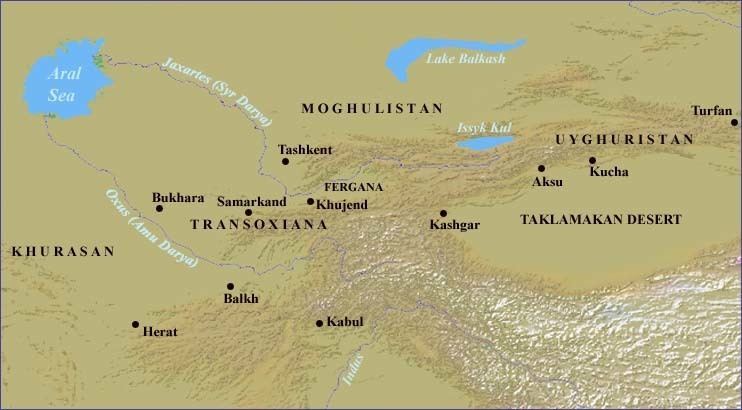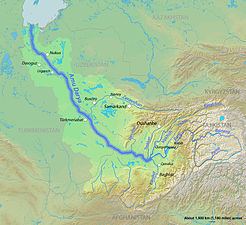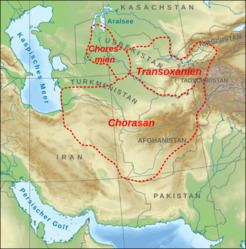 | ||
A closer look to the history of transoxiana
Transoxiana (also spelled Transoxania), known in Arabic sources as Mā warāʼ al-Nahr (Arabic: ما وراء النهر [ˈmaː waˈraːʔ anˈnahr] – 'what [is] beyond the [Oxus] river') and in Persian as Farārūd (Persian: فرارود, [fæɾɒːɾuːd]—'beyond the [Amudarya] river'), is the ancient name used for the portion of Central Asia corresponding approximately with modern-day Uzbekistan, Tajikistan, southern Kyrgyzstan, and southwest Kazakhstan. Geographically, it is the region between the Amu Darya (Ancient Greek: Ώξος Ốxos) and Syr Darya rivers. The area had been known to the Romans as Transoxania (Land beyond the Oxus), to the Arabs as Mawarannahr (Land Beyond the River), and to the Iranians as Turan, a term used in the Persian national epic Shahnameh.
Contents

The region was one of the satrapies of the Achaemenid dynasty of Persia under the name Sogdiana. Early Arab geographers named it "Bilād al-Turk" or "Turkestan," both of which mean 'the lands of the Turks'.
Transoxiana
History
The name Transoxiana stuck in Western consciousness because of the exploits of Alexander the Great, who extended Greek culture into the region with his conquests of the 4th century BCE; Transoxiana was the most north-eastern point of the Hellenistic culture until the Arab invasion. During the Sassanid Empire, it was often called Sogdiana, a provincial name taken from the Achaemenid Empire, and used to distinguish it from nearby Bactria.

The Chinese explorer Zhang Qian, who visited the neighbouring countries of Bactria and Parthia along with Transoxiana in 126 BC, made the first known Chinese report on this region. Zhang Qian clearly identifies Parthia as an advanced urban civilisation that farmed grain and grapes, made silver coins and leather goods. It was ruled successively by Seleucids, Greco-Bactrian Kingdom, Parthian Empire and Kushan Empire before Sassanid rule.

In Sassanid times, the region became a major cultural and scientific centre due to the wealth derived from the Northern Silk Road. Sassanid rule was interrupted by the Hephthalite invasion at the end of the 5th century and didn't return to the Sassanids until 565. Many Persian nobles and landlords escaped to this region after the Muslim invasion. Before the Muslim invasion it was also ruled by Göktürks. After that it was ruled by Tang China until the Arab conquest between 705 and 715, the area became known as Mā warāʼ al-Nahr (Arabic, 'what is beyond the river'), sometimes rendered as "Mavarannahr."

Transoxiana's major cities and cultural centres are Samarkand and Bukhara. Both are in the southern portion of Transoxiana, (though still to the north of the Amu Darya itself, on the river Zeravshan), and the majority of the region was dry but fertile plains. Both cities remained centres of Persian culture and civilisation after the Islamic conquest of Iran, and played a crucial role in the revival of Persian culture with establishment of the Samanid dynasty.
Part of this region was conquered by Qutayba ibn Muslim between 706 and 715 and loosely held by the Umayyads from 715 to 738. The conquest was consolidated by Nasr ibn Sayyar between 738 and 740, and continued under the control of the Umayyads until 750, when it was replaced by the Abbasids. The Tang dynasty also controlled the eastern part of the region until about the same time, when a civil war known as the An Lushan Rebellion occurred.
Genghis Khan, founder of the Mongol Empire, invaded Transoxiana in 1219 during his conquest of Khwarezm. Before his death in 1227, he assigned the lands of Western Central Asia to his second son Chagatai, and this region became known as the Chagatai Khanate. In 1369, Timur, of the Barlas tribe, became the effective ruler and made Samarkand the capital of his future empire. Transoxiana was known to be flourishing in the mid-14th century.
